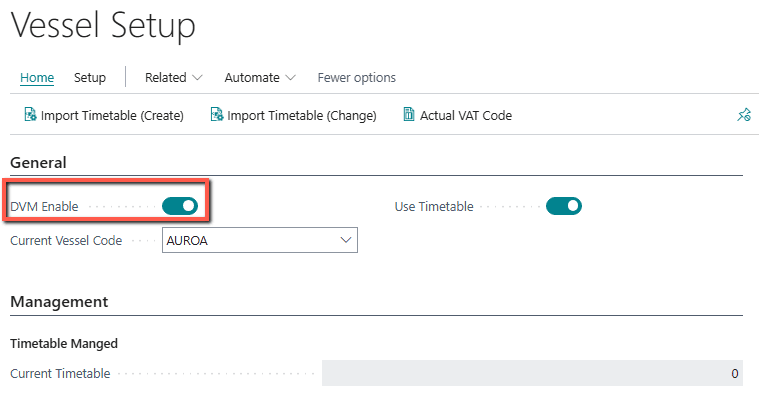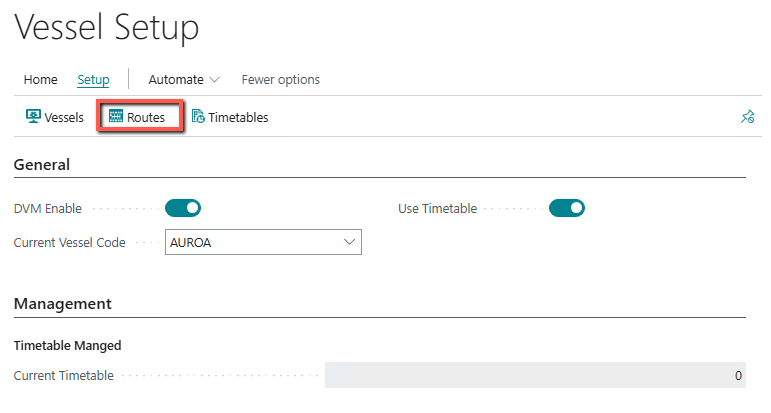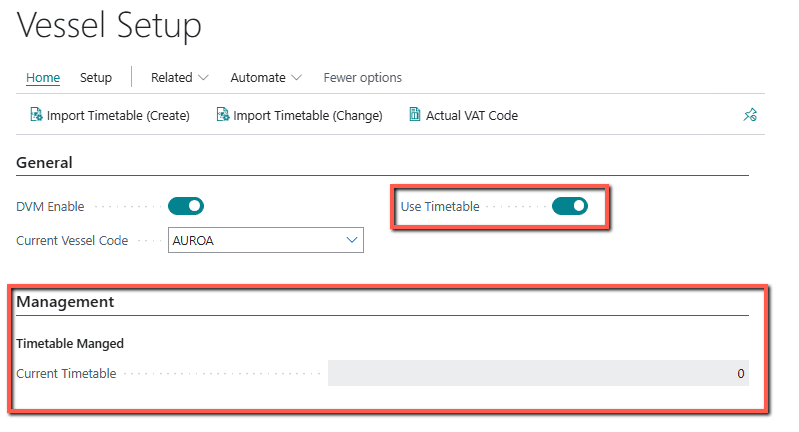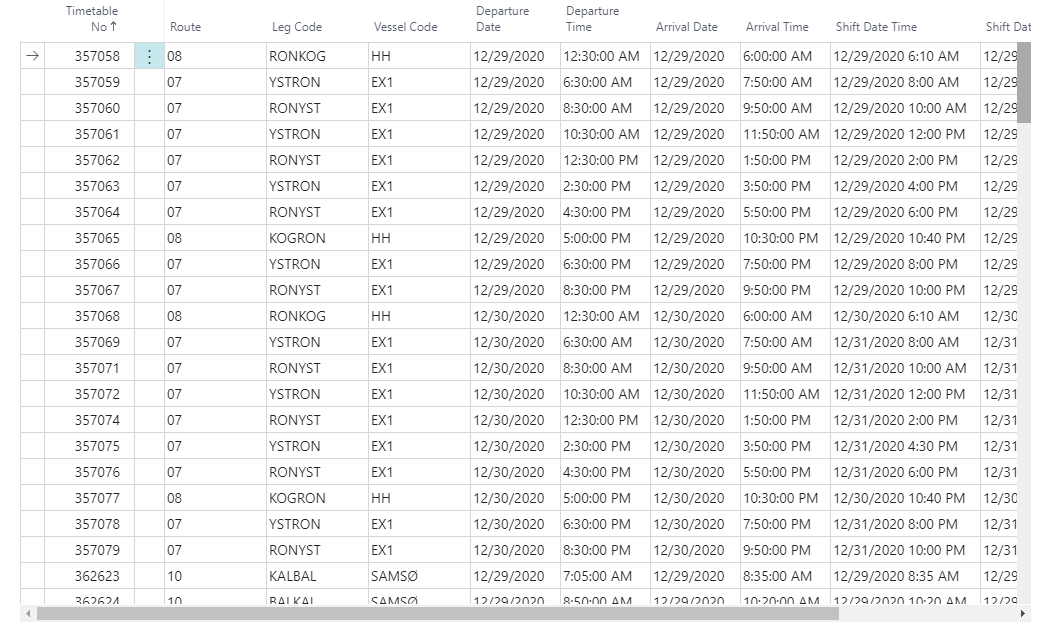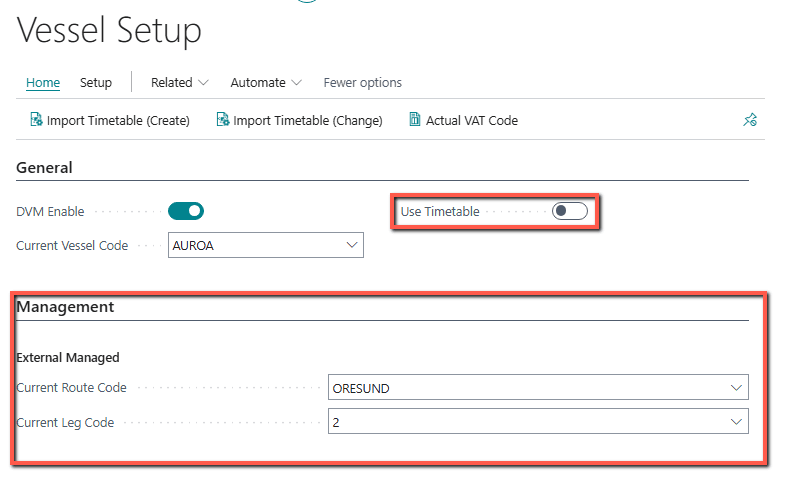General
Timetable
In the absence of a Timetable, the system defaults to the VAT Bid indicated on the Store Card. Posting Group. The module does not permit immediate changes to dimensions or other parameters not governed by the VAT posting group. The module is created in English, as a Danish translation is not currently available.
Manual VAT change
Disable Timetable inUseTo manage VAT changeds manually.
To change VAT you will need to setup POS button with the DVMCHGLEG POS Command.
This functionality, is not yet implemented.
Integrations
Please Submit a support request, to get further technical informations.
General Setup
Before Dynamic VAT Management can be used, Vessels, Routes and Legs must be created.
All routes are created in the Route table. Note that all routes found in the Timetable file must be created. Otherwise, the Timetable loading will fail.
Note! Dynamic VAT Code is enabled only if DVM Enable is checked.
Vessels
It is necessary to create All vessels, where the DVM must control VAT.
The first step is to create list of all vessels where DVM must manage VAT.
The Vessel list is accessible from the Vessel Setup.
Click Vessels to get to the List of Vessels.
| Field | Description |
|---|---|
| Code | LSC internal Vessel Code |
| External Code | The code that are used in |
| Active | Indicates, that the Vessel have DVM active (must be true, to make the vessel selectable on Vessel Setup) |
| Description | This is the full vesselname |
Routes
For all routes, Legs are created, as found in the menue.
Legs
| Field | Description |
|---|---|
| Code | LSC internal Route Code |
| External Code | The code that are used in |
| Active | Indicates, that the Vessel have DVM active (must be true, to make the vessel selectable on Vessel Setup) |
| Description | This is the full Vessel Name |
| Field | Description |
|---|---|
| Code | LSC internal Leg Code |
| Description | Descriptive text |
| External Code | The External Leg Code that are used in externalsystems |
| Harbor | Inbound or Outbound of harbor |
| External Ref. | The code that are used in external trigger-system (e.g. Blueflow) to identify the Leg |
| Field | Description |
|---|---|
| Code | LSC internal Leg Code |
| Description | Descriptive text |
| External Code | The External Leg Code that are used in externalsystems |
| Harbor | Inbound or Outbound of harbor |
| External Ref. | The code that are used in external trigger-system (e.g. Blueflow) to identify the Leg |
VAT Store Groups
For each Leg, there need to be defined VAT Bus. Posting Group.
It is possible, to define different VAT Bus. Posting Group per Store. If the Store Code field is left blank, DVM will choose this as default.
Attention! Best practice is to initially create default VAT setup (no Store Code), for each Leg, to ensure that the system can select VAT code.
| Field | Description |
|---|---|
| Store No. | LSC internal Leg Code |
| Store Description | Store Description(not editable) |
| VAT Bus. Posting Grp. Code | The VAT Bus. Posting Grp. Code that will be used in the specific Store |
| VAT Bus. Posting Grp. Description | VAT Bus. Posting Grp. Description (not editable) |
Timetable
You will also have to decide, how you are going to manage the VAT.
RTS VAT Management support 3 different ways to manage VAT changes:
- Timetable
- Manual input (POS Command)
- Automation by external applications (e.g., Blueflow)
In the following sections, you will find the necessary setups to support the various methods described above.
Timetable contains information about Route, Leg, departure and arrival.
Based on “Shift Date Time,” the time for departure is determined for the shift.
Manual Timetable import
The possibilities to perfom manual import of Timetable is found on the Vessel Setup.
Please submit a Support Request if you need information about fileformat.
Import Timetable is used for manual timetables import.
Automatic Timetable import
Additionally, there is the option to import timetables via API. Should you require information about our DVM integrations, please submit a Support Request.
No Timetable
We are currently able to to integrate to Blueflow or other similar applications, that can call our api.
To allow DVM to manage VAT without a Timetable, you must configure the specific Route and Leg you are sailing on.
The POS will now select VAT based on the Current Leg.
ATTENTION! Use of Actual VAT Code demands that default VAT setup is created for each Leg.
POS Command
Register DVM POS Commands
Go to POS External Commands and go to Register.
Here you must find and select RTS.DVM External POS Commands.
Now you are able to select DVM_CHNGLEG when setting up buttons in the POS menu.
When DVM_CHNGLEG is activated in the POS, you will get the following dialog:
Where No will cancel the changeleg Yes will give the user the posibility to select Leg:
Here after, the Leg is changed.
The flow, is following the same flow as if change are made, from e.g. BlueFlow integration.
Attention: the legchange are not performed directly, but a job is created in the Job Queue, but is processed instantly (120 milli secounds delay). I Leg-change is not performed, please verify that job is not stocked in the Job Queue (an error is occourde).
Blueflow
Setting up Blueflow (or other compatible software) integration is now possible.
Changes will be managed through Blueflow and can be monitored in the Vessel Setup (refresh the page to update).
For a technical description of how to integrate with DVM, please submit a support request.

